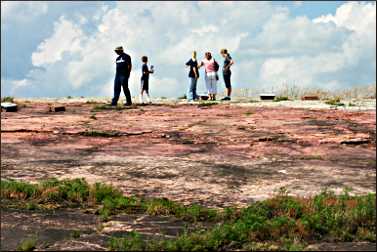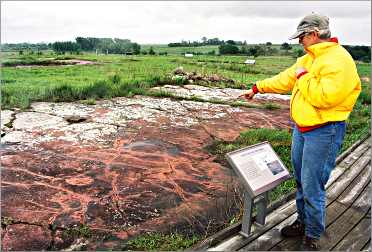Written in stone
In southwest Minnesota, the Jeffers Petroglyphs tell a dramatic but mysterious story.

© Beth Gauper
In the middle of farm fields, on a slab of the same Sioux quartzite that pops out of the sod farther west at Pipestone and Blue Mound, the story of an ancient people is written with nearly 2,000 characters.
They're dramatic characters — serpents of the underworld, and thunderbirds who shoot lightening bolts from their eyes.
There are buffalos and stick figures and atlatls, a spear-throwing device, but no bow and arrows, which began to replace the atlatl 1,000 years ago.
There are handprints, said to be the place where "rock men," or spirits, closed the rock when they emerged. These spirits, according to Algonquian tribes, had the power to enter rock and exchange tobacco for medicine.
The tales these characters tell — parables or creation stories, perhaps — were deeply significant to the people who began making the carvings about 5,000 years ago, and the site still is considered powerful by their modern descendants.
Yet they're stories no one knows how to read.
That makes the Jeffers Petroglyphs an intriguing mystery. Even seeing the carvings is difficult; in broad sunlight, they tend to fade into the stone.
In the 1940s and '50s, this 1,000-foot-long outcropping was a hangout for local teens, who'd drive up to it with their buddies and a case of beer.
The state made it into a historic site in 1966, and in 1998, the Minnesota Historical Society opened an interpretive center.
A visitor's first stop is the theater, where an eight-minute multimedia film does no interpreting — only suggesting, via wordless images of long-ago Indians gathering around the campfire, watching the northern lights and stalking buffalo.
Outside, a path through native and replanted prairie leads to the petroglyphs, where guides help visitors pick out the carvings, reproduced on plaques at trail side.
Some are easy to recognize, such as turtles and fish, but there are also rows of dots and circles and other irregular forms impossible to interpret.

© Beth Gauper
"This is the holy land of Native American culture, really," said Kevin Kallin, an archaeology student who was the guide when I visited. "It's hard to try to interpret someone else's religion. We're pretty much in the dark about it."
But since the visitors center opened, said site manager Tom Sanders, the descendants of those who etched the stone — the Arapaho, Cheyenne, Dakota, Lakota, Shoshone, Iowa — gradually have come forward.
"What they're telling me is, this is a prayer place," he said. "The carvings represent spirits, and they're helpful spirits. They don't go to the Creator to pray; he's the last resort. They go to these spirits, like Catholics with their saints."
But he cautions that there is no firm parallel, and that no symbol has one meaning for everyone.
"An Iowa (Indian) can come and say, 'This means this,' and a Dakota may say, 'This means that,' " Sanders said. "Both are true; both are meanings given to them in a vision by the Creator."
As at the nearby quarries of Pipestone and the cliffs of Blue Mounds, it's easy to see why this prairie anomaly — red, the color of life — always has been considered a spiritual place.
"It's this pink thing that floats in a sea of green," he says. "There's a sense that it's the center of the world, much like Stonehenge."
According to the tradition, the Creator left the carvings. Whoever did them was highly motivated: Sioux quartzite, once sand at the edge of a red ocean that was cooked and compressed over a billion years, is among the hardest rock in the world, seemingly too hard for the stone-tipped darts and sharpened antlers that carvers would have used.
When I was there, Texas A&M grad student Debra Dandridge had just broken three donated diamond-tipped drill bits in an attempt to extract samples for her study on how lichen affects rock art: "So they used something very, very hard," she said.
Despite the unexpected loss, Dandridge, who also had visited petroglyph sites in Nevada, Utah and New Mexico, was delighted by the site.
"It's fabulous," she said. "This is a big storybook. The stories are here — we just don't know how to understand them."
There's only one thing we know for sure: These were stories the ancients badly wanted to tell.

© Beth Gauper
Trip Tips: Jeffers Petroglyphs in southwest Minnesota
Getting there: It's a three-hour drive west of the Twin Cities.
From U.S. 14, seven miles west of Springfield, take U.S. 71 south to County Road 10. Go three miles east, then south on County Road 2 for one mile.
Hours: The visitors center is open Thursday through Sunday from June through Labor Day, then Saturdays only through late October.
Visitors can walk out to the petroglyphs even when the visitors center is closed. Dawn and dusk are the best times of day to see them, and winter, when the low arc of the sun creates shadows, is the best season.
On sunny days, however, staff naturalists help visitors see the petroglyphs by using a board, to cast shadow, and a mirror, to spotlight the carvings.
Admission: $12, $8 children 5-17.
Special events: Watch for "Starry Night, Prairie Night," a tour from 6 p.m. to midnight to watch the constellations and discover wildlife (bring a flashlight).
Information: Jeffers Petroglyphs, 507-628-5591.
Related sites nearby: The interpretive center of Pipestone National Monument, an hour west, contains slabs bearing petroglyphs carved into quartzite there, and they're much easier to see.
Blue Mounds State Park, just north of Luverne, features dramatic cliffs of jagged quartzite.
For more, see Road trip: Southwest Minnesota.